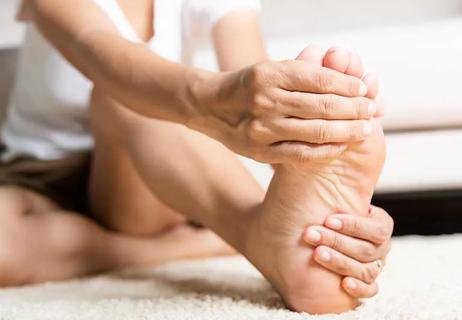Sciatica pain can keep you up — here’s how to get relief

Sleeping and sciatica don’t mix. Who can possibly get a good night’s rest if their back or legs are throbbing or tingling? (No one.)
Advertisement
Cleveland Clinic is a non-profit academic medical center. Advertising on our site helps support our mission. We do not endorse non-Cleveland Clinic products or services. Policy
But there’s hope: Yes, you can get to the bottom of that sciatica pain and stop feeling like a zombie. Physical therapist Cara Sieberth, PT, tells us what you can do to get relief from sciatica and finally get some shut-eye.
Sciatica refers to nerve pain that happens when your sciatic nerve is compressed, irritated or injured. The sciatic nerve starts in your pelvis, runs through your buttocks and down your leg to the knee. At the knee, it connects to other nerves that run down the calf and through the foot.
Sciatica isn’t the same as lower back pain. Lower back pain is limited to pain in an area of your back. But if you have sciatica, you might notice:
The location of sciatica pain can vary depending on which area of the nerve is affected. “You could feel pain or tingling down the front, back or side of your leg,” Sieberth says. “The pain can be constant, or it might bother you when you sit or lie in certain positions.”
Getting relief from sciatica takes some detective work. First, try to find out the cause. Then you can take steps to address it. This might require a visit to your doctor and some sessions with a physical therapist.
Advertisement
Causes of sciatica include:
“The cause of your sciatica affects what positions or activities bother you,” Sieberth says. “This will also determine which sleeping positions work for you. For instance, someone with a bulging disc may find back sleeping comfortable, while someone with stenosis might prefer side sleeping.”
There’s no perfect sleeping position, mattress or pillow that always works for sciatica pain. But that doesn’t mean you have to suffer night after night. With the help of a physical therapist, you can figure out which sleeping position will work best for you.
As a starting point, see if sleeping with a straight back is comfortable for you. “Many people find that getting their spine in a neutral position is helpful,” says Sieberth.
“When you lie down, ensure that your head, shoulders and hips are in a straight line,” she adds. “Put a small pillow under your neck and head but not your shoulders. Sometimes it’s necessary to put a pillow under your knees to prevent your back from arching too much. Once you get in this position, think about what hurts or what feels good. Then you can tweak your sleeping position from there.”
Some people find that side sleeping is comfortable. It can take some of the pressure off your sciatic nerve, especially if you sleep on the side opposite of where it hurts.
“Putting a pillow between your knees can make side sleeping more comfortable,” Sieberth says. “It aligns your hips and takes pressure off the pelvis. Another option is to place a pillow behind your back for support. This also keeps you from rolling onto your back.”
If spinal stenosis is causing your sciatica, bending forward slightly may give you some relief. A bent-forward position helps open the narrowed spaces in the spine.
You can mimic this at night and get some quality sleep by:
Stomach sleeping isn’t for everyone. It forces you to turn your head to one side and arch your back. However, it works for a few people. If you get relief from arching your back, you might find stomach sleeping to be helpful.
“If stomach sleeping isn’t causing back or neck pain, you can usually keep doing it,” Sieberth says. “For a few people, arching their back actually provides relief from sciatica. Stick with this sleeping position if it feels good to you.”
Advertisement
Because there are so many variations in sciatica pain, there’s no mattress that works for everyone. Some people find relief from an extra firm mattress or even sleeping on the floor. Others can’t get a wink unless they have a soft, cushy pillow-top mattress.
“You don’t have to get a new mattress right away if you have sciatica,” Sieberth says. “Instead, use the mattress you have to find a comfortable position. Use your pillows or even a mattress topper to make some small changes first. Once you figure out what gives you some relief, then you can decide whether a firmer or softer mattress might work for you.”
Whatever is causing your sciatica, don’t assume you have to live with it. If it’s interfering with your quality of sleep (and life), talk with your healthcare provider about solutions, including a referral for physical therapy.
“Even just a few sessions with a physical therapist can be helpful for many people,” Sieberth says. “Your therapist can help you figure out which sleeping positions and activities are best for you. Sciatica is such an individual condition, so there’s no one-size-fits-all solution.”
With the right medical treatment, you can get relief from sciatica pain — and head off to dreamland again.
Advertisement
Advertisement
Learn more about our editorial process.
Advertisement

It typically happens when blood flow is blocked when a limb rests in the same position too long

Tips for getting relief from a common pain of pregnancy

How to find relief

Manual therapy offers relief without the unwanted side effects of medication

Most recommended precautions center around minimizing bruising or swelling

Even one drink can have an impact on your cognitive function leading to slurred speech, blurred vision and impaired memory

Type 2 diabetes isn’t inevitable with these dietary changes

Applying a hot or cold compress can help with pain